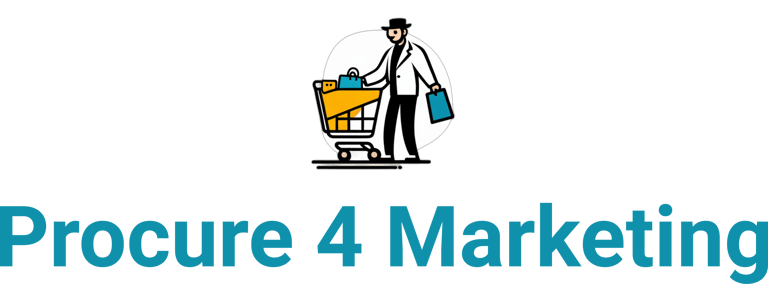Overview of Procurement Processes.
What is the procurement process? This simple guide explains the 7 key steps, from identifying a need and selecting suppliers to processing payment and managing the relationship.
SUPPLY CHAIN
The Procure 4 Marketing Team
12/4/20233 min read


Quick Answer: What is the procurement process?
The procurement process is the strategic, step-by-step method a company uses to acquire the goods and services it needs to operate. The process typically involves 7 key steps: 1) Identifying the Need, 2) Selecting Suppliers, 3) Negotiating a Contract, 4) Creating a Purchase Order (PO), 5) Receiving and Inspecting Goods, 6) Processing Payment, and 7) Managing the Supplier Relationship. A well-managed process ensures a company gets the best value without sacrificing quality.
What is the Procurement Process?
The procurement process, sometimes called the procurement cycle, is the formal journey of finding, acquiring, and paying for goods or services from an external source. It's much more than just "purchasing." While purchasing is the simple act of buying, procurement is the entire strategic process that happens before, during, and after the purchase to ensure the company's needs are met efficiently and cost-effectively.
The 7 Steps of the Procurement Process
Let's walk through the 7 key steps using a simple, consistent example: an office needing to buy 100 new laptops.
Step 1: Identify the Need
The process begins when a department recognizes a need. This need is formalized in a document, often called a purchase requisition.
Example: The IT department determines that 100 employees need new laptops. They create a requisition specifying the required technical specs (e.g., processor speed, RAM, screen size) and the desired delivery date.
Step 2: Research & Select Suppliers
Once the need is defined, the procurement team researches, vets, and selects the best possible supplier.
Example: The procurement team identifies three potential laptop suppliers. They evaluate them based on criteria like cost (price per laptop), quality (product reviews and reliability), delivery speed, and the supplier's ethical practices.
Step 3: Negotiate & Create a Contract
After selecting the best supplier, the team negotiates the terms to get the best value and create a formal contract.
Example: The team negotiates with the chosen supplier and agrees on a price of $900 per laptop (a 10% volume discount), a 30-day payment term, and a guaranteed delivery date. These terms are formalized in a signed contract.
Step 4: Create a Purchase Order (PO)
The Purchase Order (PO) is a legally binding document sent to the supplier to officially place the order.
Example: The procurement team sends a PO to the supplier for "100 units of Model X Laptop at $900/unit," referencing the contract number. This authorizes the supplier to ship the goods.
Step 5: Receive and Inspect the Goods
When the goods arrive, they are received and inspected to ensure they match the PO and meet the required quality standards.
Example: The 100 laptops arrive at the office. The receiving department checks that the delivery contains the correct model and quantity and inspects a sample of the laptops to ensure they are not damaged.
Step 6: Process the Invoice and Payment
Once the goods are approved, the supplier's invoice is checked against the PO and delivery receipt (a "3-way match"). If everything aligns, the invoice is approved, and payment is processed.
Example: The accounting department confirms the invoice for $90,000 is correct and processes the payment to the supplier within the agreed-upon 30-day term.
Step 7: Maintain Records and Manage the Relationship
The final step involves storing all transaction records for auditing purposes and managing the ongoing relationship with the supplier.
Example: All documents (contract, PO, invoice) are saved. The procurement team tracks the supplier's performance. If the delivery was on time and the quality was excellent, they are more likely to use this supplier for future needs.
What are the Different Types of Procurement?
Direct Procurement: Acquiring goods that are directly used to create a final product (e.g., a car manufacturer buying steel and tires).
Indirect Procurement: Acquiring goods and services needed for day-to-day operations but not part of the final product (e.g., office supplies, cleaning services).
Strategic Procurement: A long-term, big-picture approach focused on aligning procurement with company goals, such as building supplier partnerships and analyzing market trends.
Tactical Procurement: The day-to-day, transactional activities of purchasing goods to meet immediate needs.
Frequently Asked Questions (FAQ)
Q1: What's the difference between procurement and purchasing?
Purchasing is the single act of buying something (placing an order and making a payment). Procurement is the entire strategic process, which includes identifying needs, vetting suppliers, and negotiating contracts before the purchase, and managing the relationship after. Purchasing is just one step in the procurement process.
Q2: What is a "purchase requisition"?
A purchase requisition is an internal document used by an employee to request the purchase of a good or service. It's the official starting point of the procurement process. It must be approved before the procurement team can create a formal Purchase Order to send to a supplier.
Q3: What is "e-procurement"?
E-procurement refers to using digital software and platforms to manage the procurement process. This technology automates tasks like issuing purchase orders, processing invoices, and managing supplier information, which increases efficiency and reduces errors.

